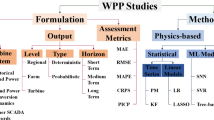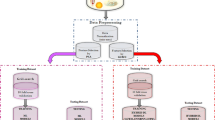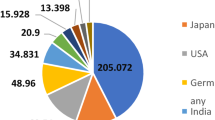Abstract
Accurate wind power forecasting plays an increasingly significant role in power grid normal operation with large-scale wind energy. The precise and stable forecasting of wind power with short computational time is still a challenge owing to various uncertainty factors. This study proposes a hybrid model based on a data prepossessing strategy, a modified Bayesian optimization algorithm, and the gradient boosted regression trees approach. More specifically, the powerful information mining ability of maximum information coefficient is used to select the important input features, and the modified Bayesian optimization algorithm is introduced to optimize the hyperparameters of the gradient boosted regression trees to acquire more satisfactory forecasting precision and computation cost. Datasets from a Chinese wind farm are used in case studies to analyze the prediction accuracy, stability, and computation efficiency of the proposed model. The point forecasting and multi-step forecasting results reveal that the performance of the hybrid forecasting model positively exceeds all the contrasted models. The developed model is extremely useful for enhancing prediction precision and is a reasonable and valid tool for online prediction with increasing data.










Similar content being viewed by others
References
Kim D, Hur J (2018) Short-term probabilistic forecasting of wind energy resources using the enhanced ensemble method. Energy 157:211–26
Zhang Y, Le J, Liao X, Zheng F, Li Y (2019) A novel combination forecasting model for wind power integrating least square support vector machine, deep belief network, singular spectrum analysis and locality-sensitive hashing. Energy 168:558–572
Zhang J, Meng H, Gu B, Li P (2020) Research on short-term wind power combined forecasting and its Gaussian could uncertainty to support the integration of renewables and EVs. Renew Energy 153:884–s899
Zameer A, Arshad J, Khan A, Raja MAZ (2017) Intelligent and robust prediction of short term wind power using genetic programming based ensemble of neural networks. Energy Conver Manag 134:361–72
Sun G, Jiang C, Cheng P, Liu Y, Wang X, Fu Y et al (2018) Short-term wind power forecasts by a synthetical similar time series data mining method. Renewable Energy. Renew Energy 115:575–84
Li L-L, Zhao X, Tseng M-L, Tan RR (2020) Short-term wind power forecasting based on support vector machine with improved dragonfly algorithm. J Cleaner Prod 242:118447
Hong Y-Y, Rioflorido CLPP (2019) A hybrid deep learning-based neural network for 24-h ahead wind power forecasting. Appl Energy 250:530–9
Ahmad MW, Mourshed M, Rezgui Y (2018) Tree-based ensemble methods for predicting PV power generation and their comparison with support vector regression, Energy 164:465–74
Agrawal RK, Muchahary F, Tripathi MM (2019) Ensemble of relevance vector machines and boosted trees for electricity price forecasting. Appl Energy 250:540–8
García Nieto PJ, García–Gonzalo E, Arbat G, Duran–Ros M, et al (2018) Pressure drop modelling in sand filters in micro-irrigation using gradient boosted regression trees. Biosyst Eng 171:41–51
Landry M, Erlinger TP, Patschke D, Varrichio (2016) Probabilistic gradient boosting machines for GEFCom2014 wind forecasting. Int J Forecast 32:1061–1066
Persson C, Bacher P, Shiga T, Madsen H (2017) Multi-site solar power forecasting using gradient boosted regression trees. Solar Energy 150:423–36
Yu X, Wang Y, Wu L, Chen G, Wang L, Qin H (2020) Comparison of support vector regression and extreme gradient boosting for decomposition-based data-driven 10-day streamflow forecasting. J Hydrol 58:12429
Pan Y, Chen S, Qiao F, Ukkusuri SV, Tang K (2019) Estimation of real-driving emissions for buses fueled with liquefied natural gas based on gradient boosted regression trees. Sci Total Environ 66:741–50
Torres-Barrán A, Alonso Á, Dorronsoro JR (2019) Regression tree ensembles for wind energy and solar radiation prediction. Neurocomputing 326-327:151–60
Doke P, Shrivastava D, Pan C et al (2020) Using CNN with Bayesian optimization to identify cerebral micro-bleeds. Mach Vis Appl 31:36
Liu J, Jiang C, Zheng J (2020) Batch Bayesian optimization via adaptive local search. Appl Intell. https://doi.org/10.1007/s10489-020-01790-5
Jia W, Xiu-Yun et al (2019) Hyperparameter Optimization for Machine Learning Models Based on Bayesian Optimization. J Electron Scie Technol 17(1):26–40
Golovin D, Solnik B, Moitra S, Kochanski G, Karro J, Sculley D (2017) Google vizier: a service for black-box optimization. In: Proc. of the 23rd ACMSIGKDD International Conference on Knowledge Discovery and Data Mining, pp 1487–1495
Cho H, Kim Y, Lee E, Choi D, Lee Y, Rhee W (2020) Basic Enhancement Strategies When Using Bayesian Optimization for Hyperparameter Tuning of Deep Neural Networks. IEEE Access 8:52588–52608
Xia Y, Liu C, Li Y, Liu N (2017) A boosted decision tree approach using Bayesian hyper-parameter optimization for credit scoring. Expert Syst Appl 78:225–41
Yan J, Zhang H, Liu Y, Han S, Li L (2019) Uncertainty estimation for wind energy conversion by probabilistic wind turbine power curve modelling. Appl Energy 239:1356–70
Yu R, Liu Z, Li X, Lu W, Ma D, Yu M et al (2019) Scene learning: Deep convolutional networks for wind power prediction by embedding turbines into grid space. Appl Energy 238:249–57
Liu J, Wang X, Lu Y (2017) A novel hybrid methodology for short-term wind power forecasting based on adaptive neuro-fuzzy inference system. Renew Energy 103:620–9
Iuchi H, Sugimoto M, Tomita M (2018) MICOP: Maximal information coefficient-based oscillation prediction to detect biological rhythms in proteomics data. BMC Bioinform 19(1):249
Sharmin S, Shoyaib M, Ali AA, Khan MAH, Chae O (2019) Simultaneous feature selection and discretization based on mutual information. Pattern Recogn 91:162–74
Fu T, Tang X, Cai Z, Zuo Y, Tang Y, Zhao X (2020) Correlation research of phase angle variation and coating performance by means of Pearson’s correlation coefficient. Progress Organ Coat 139:105459
JAK SA (2018) Aspect-based opinion ranking framework for product reviews using a Spearman’s rank correlation coefficient method. Inf Sci 460-461:23–41
Juez-Gil M, Erdakov IN, Bustillo A, Pimenov DY (2019) A regression-tree multilayer-perceptron hybrid strategy for the prediction of ore crushing-plate lifetimes.J Adv Res 18:173–84
Song Y, Zhou H, Wang P, Yang M (2019) Prediction of clathrate hydrate phase equilibria using gradient boosted regression trees and deep neural networks. J Chem Thermodyn 135:86–96
Chen X, Zhang S, Li L (2019) Multi-model ensemble for short-term traffic flow prediction under normal and abnormal conditions. IET Intell Transport Syst 13(2):260–268
Letham B, Karrer B, Ottoni G, Bakshy E (2017) Constrained Bayesian Optimization with Noisy Experiments. arXiv:https://arxiv.org/pdf/1706.07094
Calandra R, André Seyfarth PJ et al (2014) An experimental comparison of Bayesian optimization for bipedal locomotion. In: IEEE International Conference on Robotics and Automation (ICRA), PP 1951–1958
Klein A, Falkner S, Bartels S, Hennig P, Hutter F (2017) Fast bayesian optimization of machine learning hyperparameters on large datasets. Proc Mach Learn Res 54:528–536
Loukatou A, Howell S, Johnson P, Duck P (2017) Stochastic wind speed modelling for estimation of expected wind power output. Appl Energy 22:1328–40
Wang G, Jia R, Liu J, Zhang H (2020) A hybrid wind power forecasting approach based on Bayesian model averaging and ensemble learning. Renew Energy 145:2426–2434
Zhang J, Yan J, Infield D, Liu Y Lien F-s(2019) Short-term forecasting and uncertainty analysis of wind turbine power based on long short-term memory network and Gaussian mixture model. Appl Energy 241:229–44
Wang X, Wang J, Zhang K, Lin F, Chang Q (2020) Convergence and objective functions of noise-injected multilayer perceptrons with hidden multipliers. Neurocomputing https://doi.org/10.1016/j.neucom.2020.03.119
Callens A, Morichon D, Abadie S et al (2020) Using Random forest and Gradient boosting trees to improve wave forecast at a specific location. Appl Ocean Res 104:102339
Zhou T, Jiang Z, Liu X, Tan K (2020) Research on the long-term and short-term forecasts of navigable river’s water-level fluctuation based on the adaptive multilayer perceptron. J Hydrol 591:125285
Xue L, Liu Y, Xiong Y et al (2021) A data-driven shale gas production forecasting method based on the multi-objective random forest regression. J Petrol Sci Eng 196:107801
Yeşilkanat CM (2020) Spatio-temporal estimation of the daily cases of COVID-19 in worldwide using random forest machine learning algorithm. Chaos Solitons Fractals 140: 110210
Acknowledgements
This work was supported by Natural Science Basic Research Plan in Shaanxi Province of China (Grant No.2018ZDXM-GY-169), Key project of Natural Science Basic Research Plan in Shaanxi Province of China (Grant No. 2019ZDLGY18-03) and Scientific and technological projects in Henan Province of China (Grant NO.162102210236).
Author information
Authors and Affiliations
Corresponding author
Ethics declarations
Conflict of Interests
The authors declare that they have no conflict of interest.
Additional information
Publisher’s note
Springer Nature remains neutral with regard to jurisdictional claims in published maps and institutional affiliations.
Rights and permissions
About this article
Cite this article
Huang, H., Jia, R., Shi, X. et al. Feature selection and hyper parameters optimization for short-term wind power forecast. Appl Intell 51, 6752–6770 (2021). https://doi.org/10.1007/s10489-021-02191-y
Accepted:
Published:
Issue Date:
DOI: https://doi.org/10.1007/s10489-021-02191-y




